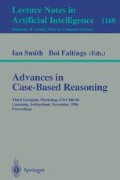Abstract
The paper describes a novel architecture for image understanding. It is based on acquisition of radiologist knowledge, and combines low-level structure analysis with high-level interpretation of image content, within a task-oriented model. A case based reasoner working on a segment case-base contains the individual image segments. These cases with labels are considered indexes for another case based reasoner working on an organ interpretation case base. Both are Creek type case based reasoners, here operating within a propose-critique-modify task structure. Methods for criticizing suggested interpretations by way of explanation, and how interpretations may be modified, are presented. An example run illustrates the system architecture and its key concepts.
Preview
Unable to display preview. Download preview PDF.
References
Aamodt A., A Knowledge-Intensive, Integrated Approach to Problem Solving and Sustained Learning, Ph.D. thesis, May 1991, Dept. of Computer Systems and Telematics, University of Trondheim, Norway
Aamodt A., Explanation-Driven Case-Based Reasoning, pp. 274–288 in Topics in case-based reasoning by Wess S. et al. (eds.), Springer 1994, pp. 274–288.
Aamodt A. and Plaza E, Case-Based Reasoning: Foundational issues, methodological variations, and system approaches, AI Communications, Vol 7, no.1, pp. 39–59.
Aamodt A., Knowledge acquisition and learning by experience — the role of case specific knowledge, in Machine Learning and Knowledge Acquisition, Academic Press 1995, ISBN 0-12-685120-4, pp. 197–245.
Aha, D., Weighting features, In Veloso, M. and Aamodt, A. (eds.) Case-based reasoning research and development, First International Conference, ICCBR-95, Sesimbra, Portugal, October 1995, Springer Verlag, 1995, pp 347–358.
Berger J., Roentgen: Radiation Therapy and Case-based Reasoning, Artificial Intelligence Laboratory, University of Chicago, Chicago, Illinois 60637.
Chandrasekaran B., Design Problem Solving: A Task Analysis, AI Magazine, Winter 1990.
Chandrasekaran B. and Johnson T., Generic Tasks and Task Structures: History, Critique and New Directions in David, J.-M. et al. (eds.), Second Generation Expert Systems, Springer 1993, ISBN 3-540-56192-7.
Chellappa R and Kashyap, R.L., Image understanding, In Shapiro, S.C (ed.), Encyclopedia of artificial intelligence, Vol 1, John Wiley & Sons, 1992pp 641–663.
Davis D. and Taylor C., A Blackboard Architecture For Medical Image Interpretation, SPIE Vol. 1445 Image Processing (1991).
Englmeier K. et al., Model Based Image Interpretation of Spiral CT Scans of the Abdomen, pp. 44–51, in Artificial Intelligence in Medicine by Andreassen S., Engelbrecht R and Wyatt J. (eds.), IOS Press 1993.
Gonzales R. and Woods R., Digital Image Processing, Addison Wesley 1992, ISBN 0-201-50803-6.
Grimnes M. and Ødegård A., Knowledge acquisition for robust image understanding: Knowledge use in CT image understanding, Report at dept. of Informatics, NTNU, ftp://sophus.ifi.unit.no/YarcWorld/public/papers-reports/kacq.kn-use. 19-01-96.ps
Grimnes, M., Knowledge breadth in CT image diagnosis, Submitted for publication, 1996.
Gong L. and Kulikowski C., Composition of Image Analysis Processes Through Object-Centered Hierarchical Planning, IEEE Transactions on Pattern Analysis and Machine Intelligence, Vol. 17, No. 10, October 1995.
Haddad M et al., SCINA: A Case-Based Reasoning System for the interpretation of Myocardial Perfusion Scintigrams, Dept. of Cardiology, University of Vienna, AKH Wien, Vienna, Austria, email: haddad@vm.akh-wien.ac.at
Kummert F. et al., Control and explanation in a signal understanding environment, Signal Processing 32 (1993) 111–145
Focusing construction and selection of abductive hypotheses. In IJCAI, 1993, pp. 24–31. Morgan Kaufmann.
Macura R. and Macura K., MacRad: Radiology Image Resource with a Case-Based Retrieval System, pp. 43–54, in Veloso M. and Aamodt A. (eds.), Case-Based Reasoning Research and Development, Springer 1995, ISBN3-540-60598-3
Menhardt W. et al., Knowledge Based Interpretation of Cranial MR Images, Philips GmbH, Forschungslaboratorium Hamburg POBox 540840 D-2000 Hamburg 54, FRG
Rogers E., VIA-RAD: a blackboard-based system for diagnostic radiology, Artificial Intelligence in Medicine 7 (1995), pp. 343–360
Schalkoff R., Pattern Recognition. Statistical, Structural and Neural Approaches, Wiley 1992, ISBN 0-471-55238-0
Steels L., Components of Expertise, AI Magazine summer 1990.
Steels, L., The component framework and its role in reusability, In David, J-M. et al. (eds.), Springer 1993, ISBN 3-540-56192-7, pp. 273–298.
Swett H. et al., Computer Vision and Decision Support, pp. 273–313 in The Perception of Visual Information by Hendee W. and Wells P. (eds.), Springer 1993
Teller A. and Veloso M., PADO: A new learning architecture for object recognition, Symbolic visual learning. Oxford University Press, 1995.
Tombropoulos R. et al., A Decision Aid for Diagnosis of Liver Lesions on MRI, Section on Medical Informatics, Stanford University School of Medicine, 1994 AMIA
Vernazza G.L. et al., A Knowledge-Based System for Biomedical Image Processing and Recognition, IEEE Transaon Circuits and Systems, Vol. cas-34, no. 11, November 1987
Wess, S., Althoff, K-D., Derwand, G., Using k-d trees to improve the retrieval step in case-based reasoning, In Wess. S., Althoff, K-D., and Richter, M.M. (eds.) Topic in case-based reasoning, Springer Verlag, 1994, pp. 167–181.
Wegener O., Whole Body Computed Tomography, 2nd ed., Blackwell scientific pub. 1992, ISBN 0-86542-223-0
Wielinga B. et al., Towards a Unification of Knowledge modeling Approaches, in David, J-M. e al. (ed), Second Generation Expert Systems, Springer 1993, ISBN 3-540-56192-7.
Winnem O., Integrating knowledge level and symbol level modeling — The Creest Workbench, MSc thesis, Dept. of Informatics, Norwegian University of Science and Technology — NTNU, Trondheim, 1996.
Author information
Authors and Affiliations
Editor information
Rights and permissions
Copyright information
© 1996 Springer-Verlag Berlin Heidelberg
About this paper
Cite this paper
Grimnes, M., Aamodt, A. (1996). A two layer case-based reasoning architecture for medical image understanding. In: Smith, I., Faltings, B. (eds) Advances in Case-Based Reasoning. EWCBR 1996. Lecture Notes in Computer Science, vol 1168. Springer, Berlin, Heidelberg. https://doi.org/10.1007/BFb0020609
Download citation
DOI: https://doi.org/10.1007/BFb0020609
Published:
Publisher Name: Springer, Berlin, Heidelberg
Print ISBN: 978-3-540-61955-0
Online ISBN: 978-3-540-49568-0
eBook Packages: Springer Book Archive

